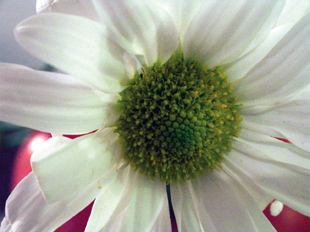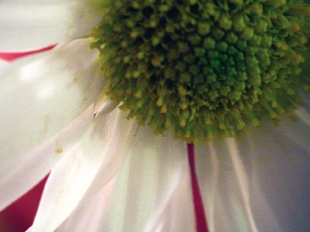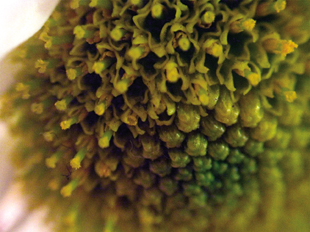Hack 22 Get Super Close
| < Day Day Up > |
| Digital cameras have macro capability built right in. But what if you want to get real close? Here's how to get a bug's-eye view of the world . Since the early roots of photography, people have been fascinated with capturing the world up close. Super close. Bumps-on-a-frog close. Most digital cameras come with a Macro mode that allows you to get very close to your subject. Sometimes, this mode is simply called Close Up and is denoted by a flower icon on your camera. Depending on your camera, close can be defined as anything from 6 inches to 18 inches. But what if you want to see the very pores ? This hack will help you get started. There are a few ways to get these types of startling shots. The first way is to buy a macro lens that is designed specifically for this type of shooting. Unfortunately, these lenses are often quite pricey. A second option is to buy extension tubes for your DSLR. An extension tube is a light-tight tunnel that extends the distance from your lens to the camera body, thereby increasing magnificationthe greater the distance, the more magnification. But what if your digital camera isn't an SLR or doesn't take interchangeable lenses? The third, and most affordable, option is to buy a close-up lens that mounts on top of your current lens, the same way that filters attach. Some cameras have adapters for these auxiliary lenses. But if yours doesn't, third-party manufacturers such as Raynox (http://www.raynox.co.jp/index.htm) have devised clever workarounds to enable this capability on just about any digital camera. The advantages are that you don't have to buy a whole new lens and that you can use the close-up lens with any camera, including an SLR. This is the tool we're going to use for this hack. 2.8.1 Get the GlassFirst, go down to your friendly photo dealer and see what type of close-up attachments are available for your camera. I've had a lot of luck with the aforementioned Raynox lens, which is well made, affordable, and readily available. Raynox makes a wide variety of goodies for all kinds of cameras, including close-up accessories for digital cameras. The lens comes with an attachment to help you mount it over your built-in glass. Turn on your camera andvoil !you have a super-macro digital camera. How close can you get? Close-up lenses are described by a diopter number that indicates how close your lens can get to the subject, in units of fractions of a meter. For example, a lens marked +12 will let you get within 1/12 of a meter (or within just 8 centimeters). For those of you inclined to use the imperial system, that's just over 2 inches awayalso known as pretty darn close ! What's fun about all of this math madness is that these measurements are based on the lens of your camera being set to infinity. If, like many cameras, yours has the ability to focus manually, you can get even closer by using the close-up lens and its built-in close-focusing setting. 2.8.2 Mount the Camera for Best ResultsSo now you have a close-up lens attached to the camera and are ready to shoot, right? Well, almost. Shooting one inch away from a subject is tricky, because the lens has very little tolerance for being even a little too far or too close to the object. If you move out of that one-inch in-focus area, your object will quickly get soft. This means that to take really good shots you need to mount your camera on a tripod.
You'll also need a good location to shoot the object. Place the object on a table with a white background, either cloth or paper. Ideally, you want your camera to be facing straight at the object. So, get a chair and sit down in front of your camera. One advantage of shooting with a tripod is that you can have long exposures without having to worry about camera shake. To be safe, either use a shutter cable or, if your camera can't accept one, use the built-in self-timer. Even the shake from you holding down the shutter button can blur the image. Try getting as close as 4x (Figure 2-10) with your regular camera lens. It won't workthat is, unless you add a little glass. But don't stop there. Try 8x (Figure 2-11)! But wait, there's more! Is 12x (Figure 2-12) close enough for you? Figure 2-10. A close-up of a flower at 4x Figure 2-11. A close-up of a flower at 8x Figure 2-12. A close-up of a flower at 12x 2.8.3 White Balance for Good Color ToneBefore taking your shot, it's a good idea to measure the white-point of the image and set your camera accordingly . This will save you lots of color-balancing work later in Photoshop. For most digital cameras, this is done by selecting the measure white-point feature on your camera and holding the shutter halfway down. The camera will then measure the light of your image and base the white-point on the particular lighting you are using. If you can't measure the white-point manually, some cameras will let you choose from a menu of presets, such as tungsten, florescent, or daylight . Set your camera appropriately to get the best color balance possible. 2.8.4 Flash Versus Available LightSo what about flash? Why bother with it if you can just use tungsten or available light? Well, one of the advantages of using flash is that you can control how the item is lit and where the shadows will fall. You can try using your camera's built-in flash, but this will often not give you the kind of control you need because the flash will be literally inches from your subject. Small soft-box flash units are ideal here, providing a soft, even, neutral light to your close-up images. You can pick up a soft box flash unit from your local pro-camera store. A soft box is simply a portable enclosure for your flash that has a translucent nylon face that softens the intensity of the flash as the light passes through it. This makes the light softer, a more suitable quality for close-ups and portraits. I recommend using two soft boxes, one on each side, to produce even illumination . 2.8.5 Final ThoughtsSuper-close-up shooting can make even everyday items more interesting and will allow you to discover a whole new way of seeing the world and creating images. Experiment with different kinds of objects, both natural and human-made, and get ready for some visual surprises . You already have the camera and, with a minimal investment, you are well on your way to capturing the world from a bug's-eye perspective. Hadley Stern |
| < Day Day Up > |
EAN: 2147483647
Pages: 161
